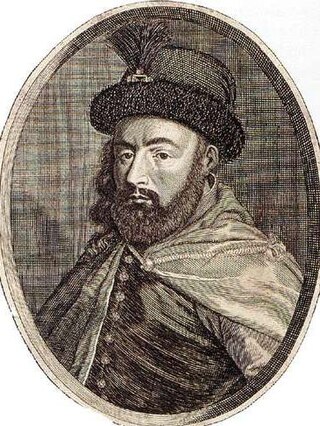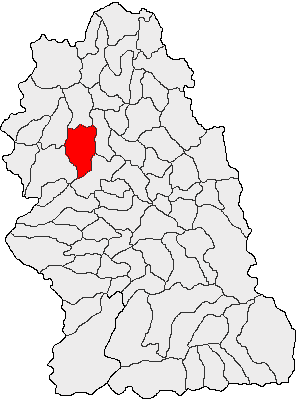Related Research Articles

Ferdinand II was Holy Roman Emperor, King of Bohemia, Hungary, and Croatia from 1619 until his death in 1637. He was the son of Archduke Charles II of Inner Austria and Maria of Bavaria. His parents were devout Catholics, and, in 1590, they sent him to study at the Jesuits' college in Ingolstadt because they wanted to isolate him from the Lutheran nobles. In July that same year (1590), when Ferdinand was 12 years old, his father died, and he inherited Inner Austria–Styria, Carinthia, Carniola and smaller provinces. His cousin, the childless Rudolf II, Holy Roman Emperor, who was the head of the Habsburg family, appointed regents to administer these lands.

Gabriel Bethlen was Prince of Transylvania from 1613 to 1629 and Duke of Opole from 1622 to 1625. He was also King-elect of Hungary from 1620 to 1621, but he never took control of the whole kingdom. Bethlen, supported by the Ottomans, led his Calvinist principality against the Habsburgs and their Catholic allies.

The House of Esterházy, also spelled Eszterházy, is a Hungarian noble family with origins in the Middle Ages. From the 17th century, the Esterházys were the greatest landowner magnates of the Kingdom of Hungary, during the time that it was part of the Habsburg monarchy and later Austria-Hungary. During the history of the Habsburg empire, the Esterházy family was consistently loyal to the Habsburg rulers. The Esterházys received the title of Graf (Count) in 1626, and the Forchtenstein line received the title of Fürst (Prince) from the Holy Roman Emperor in 1712.

Mikulov is a town in Břeclav District in the South Moravian Region of the Czech Republic. It has about 7,400 inhabitants. The historic centre of Mikulov is well preserved and is protected by law as an urban monument reservation.

Sárospatak is a town in Borsod-Abaúj-Zemplén County, northern Hungary. It lies 70 kilometres northeast from Miskolc, in the Bodrog river valley. The town, often called simply Patak, is a cultural centre, a historical town and a popular tourist destination.

George II Rákóczi, was a Hungarian nobleman, Prince of Transylvania (1648-1660), the eldest son of George I and Zsuzsanna Lorántffy.

Péter Pázmány de Panasz, S.J., was a Hungarian Jesuit who was a noted philosopher, theologian, cardinal, pulpit orator and statesman. He was an important figure in the Counter-Reformation in Royal Hungary.

George I Rákóczi was Prince of Transylvania from 1630 until his death in 1648. Prior to that, he was a leader of the Protestant faction in Hungary and a faithful supporter of Gabriel Bethlen, his predecessor as Prince. When Bohemian nobles requested military support in their struggles against the Habsburg monarchy, Rákóczi persuaded Bethlen to help and commanded Transylvanian forces in several battles. Rákóczi was elected prince after Bethlen's death, succeeding Bethlen's wife Catherine of Brandenburg and brother Istvan.

The Polish–Ottoman War (1620–1621) was a conflict between the Polish–Lithuanian Commonwealth and the Ottoman Empire over the control of Moldavia. It ended with the Commonwealth withdrawing its claims on Moldavia and to the eventual demise of the Sultan Osman II.

Ilia is a commune in Hunedoara County, Romania. The commune lies in the historical province of Transylvania. It is composed of nine villages: Bacea (Bácsfalva), Bretea Mureșană (Marosbrettye), Brâznic (Briznik), Cuieș (Kulyes), Dumbrăvița (Dumbravica), Ilia, Săcămaș (Szakamás), Sârbi (Szirb) and Valea Lungă (Valealunga).

Prince Pál Antal Esterházy de Galántha was a Hungarian prince, a member of the famous Esterházy family. He was the son of Prince Nikolaus II and succeeded his father on the latter's death in 1833.

Paul I, Prince Esterházy of Galántha was the first Prince Esterházy of Galántha from 1687 to 1713, Palatine of the Kingdom of Hungary from 1681 to 1713, and an Imperial Field Marshal. Paul was also an accomplished poet, harpsichordist, and composer. He actively participated in various battles against the Ottoman Turks during the Fourth Austro-Turkish War (1663–1664) and the Great Turkish War (1683–1699). Paul is credited with establishing the wealth, power, and influence of the Princely House of Esterházy.

Maximilian Freiherr von und zu Trauttmansdorff, was an Austrian politician and diplomat of the Thirty Years' War era. His other titles included Freiherr von Gleichenberg, Neuenstadt am Kocher, Negau, Burgau und Totzenbach, Herr zu Teinitz. He was a Knight in the Order of the Golden Fleece, Geheimer Rat, Chancellor and Obersthofmeister.

Baron, later Count Nikolaus Esterházy de Galántha was the founder of the West-Hungarian noble House of Esterházy which became one of the grandest and most influential aristocratic families of the Kingdom of Hungary.
The third Peace of Pressburg was a peace treaty concluded in Pressburg. It was signed on 30 December 1626 between Gabriel Bethlen of Transylvania, the leader of an uprising against the Habsburg monarchy from 1619–1626, and Holy Roman Emperor Ferdinand II. The agreement put an end to the revolt by confirming the Peace of Nikolsburg. In return, Bethlen agreed not to fight against the emperor anymore, nor would he ally with the Ottoman Turks.

Baron Dániel Esterházy de Galántha was a Hungarian noble, son of Vice-ispán of Pozsony County Ferenc Esterházy. He was the founder of the Csesznek branch of the House of Esterházy. His brother was, among others, Nikolaus, Count Esterházy who served as Palatine of Hungary.

Baron Pál Esterházy de Galántha was a Hungarian noble, son of Vice-ispán of Pozsony County Ferenc Esterházy. He was the founder of the Zólyom branch of the House of Esterházy. His brother was, among others, Nikolaus, Count Esterházy who served as Palatine of Hungary.

Baroness Krisztina Nyáry de Bedegh was the daughter of Baron Pál Nyáry and Katalin Várday de Kisvárda. She was the second wife of Palatine Nikolaus, Count Esterházy. Her son, among others, was Paul I, Prince Esterházy.
Count Imre Thurzó de Bethlenfalva was a Hungarian aristocrat, son of Palatine György Thurzó, who served as Perpetual Ispán of Árva County between 1616 and 1621. Count Imre also functioned as Rector of the University of Wittenberg from 1616 to 1621. He was the last male member of the prestigious Thurzó family.

Johann Georg [John George] von Brandenburg was a German nobleman and Protestant ecclesiastic in the Holy Roman Empire. He was the administrator (bishop) of Strasbourg from 1592 until 1604 and the Duke of Jägerndorf (Krnov), one of the Silesian duchies, from 1607 until 1624.
References
- ↑ Kampmann, Christoph (2016), "Trauttmansdorff, Maximilian Graf von", Neue Deutsche Biographie (in German), vol. 26, Berlin: Duncker & Humblot, pp. 376–378; ( full text online )
- ↑ Bain, Robert Nisbet (1911). . Encyclopædia Britannica . Vol. 9 (11th ed.). p. 794.
- ↑ Bain, Robert Nisbet (1911). . Encyclopædia Britannica . Vol. 3 (11th ed.). pp. 829–830.